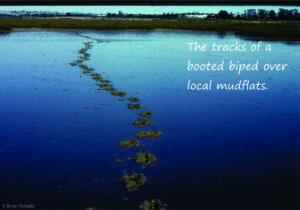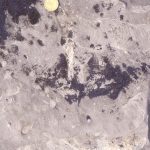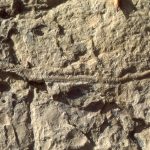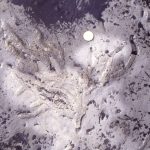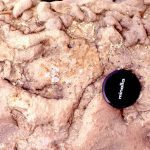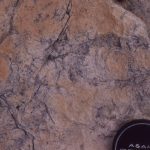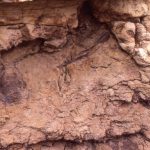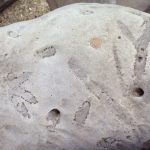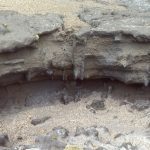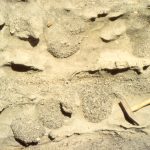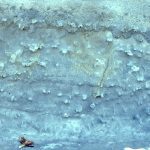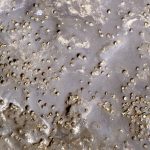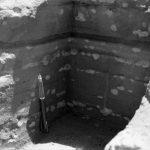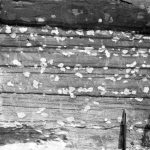Trace fossils have the privilege of being two things at once: sedimentary structures, and fossils. They occur in sediment, are made of sediment, but represent the activities of creeping, crawling or burrowing critters, mostly at or immediately below the sediment water interface (marine, lacustrine, estuarine, swamp), or subaerial environments such as dune fields. As such, trace fossils represent the range of activities that critters are normally occupied with – grazing or foraging for food, home construction and house-keeping, predating or escaping predators, wandering aimlessly, or taking a nap after an exhausting day. Some critters like to rough it, preferring the tumble of waves or strong currents, while others like the peace and quiet of deeper realms. Lives are frequently interrupted by storms or violent, turbulent flows of sand and mud; their traces, or lack of them, also reflect these events.
Most animals produce more than one kind of trace depending on what they are doing, which means that in most cases, traces reflect animal activity and biometrics, rather than the specific critter species. Most traces do not contain any remnants of the animal that made them (there are a few exceptions); finding a trilobite body fossil at the end of its scampering trail is pretty rare.
Trace fossils provide valuable information on benthic communities, environmental conditions such as wave or current energy, redox conditions, rates of sedimentation, or periods of time when sedimentation slowed (e.g. hiatuses, disconformities, omission surfaces).
Intense bioturbation can also obliterate other kinds of sedimentary structures; for a geologist, this may be an annoyance or a happy circumstance. Most Precambrian successions are free of trace fossils and bioturbation; this changed during the Ediacaran, the period that appears to have been a kind of precursor to the Cambrian invertebrate explosion. Most Phanerozoic sedimentary successions (since 540 million years ago) have enjoyed the munching-burrowing efforts of a myriad nameless critters.
Trace fossils, like regular body fossils, are part of the rock.
This link will take you to an explanation of the Atlas series, the ownership, use and acknowledgment of images. There, you will also find links to the other categories.
Click on the image for an expanded view, then ‘back page’ arrow to return to the Atlas.
The images:
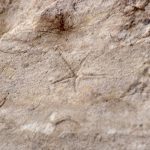 Resting impression of a brittle starfish (echinoid), Asteriacites, Jurassic, Ellesmere Island.
Resting impression of a brittle starfish (echinoid), Asteriacites, Jurassic, Ellesmere Island.
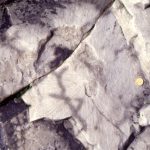 Radiating spreite of Zoophycus, organized into a 3-dimension cork-screw like structure, probably representing systematic feeding by a marine worm or similar creature. Mid-Miocene Mohakatino Fm. North Taranaki
Radiating spreite of Zoophycus, organized into a 3-dimension cork-screw like structure, probably representing systematic feeding by a marine worm or similar creature. Mid-Miocene Mohakatino Fm. North Taranaki
 A nice representation of the 3-dimensionality of spreite radiating about a central vertical burrow in Zoophycus, Permian, Canon Fiord Fm, Ellesmere Island.
A nice representation of the 3-dimensionality of spreite radiating about a central vertical burrow in Zoophycus, Permian, Canon Fiord Fm, Ellesmere Island.
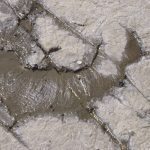 Early Miocene Zoophycus from basal Waitemata Basin mudstone (turbidite d,e interval), Matheson’s Bay, NZ.
Early Miocene Zoophycus from basal Waitemata Basin mudstone (turbidite d,e interval), Matheson’s Bay, NZ.
Two examples of Scolicia. Left: basin floor fan, Mid-Miocene Mohakatino Fm, N Taranaki. Right: shelf, Iceberg Bay Fm. Axel Heibe4rg Island.
Thalassinoides, Left from submarine fan Mohakatino Fm. N Taranaki. Right: shallow shelf, Expedition Fm. Axel Heiberg Island.
Rhizocorallium, both images from Grizzly Gorge, Yukon
 Rosselia, possible sea anemone, from mid-Jurassic Bowser Basin, Tsatia Mt. British Columbia.
Rosselia, possible sea anemone, from mid-Jurassic Bowser Basin, Tsatia Mt. British Columbia.
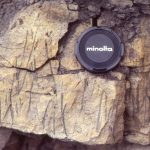 Skolithos, a worm or arthropod feeding or domicile burrow, Paleocene Expedition Fm, Axel Heiberg Island.
Skolithos, a worm or arthropod feeding or domicile burrow, Paleocene Expedition Fm, Axel Heiberg Island.
Rippled bedding, with numerous small feeding traces, one Paleophycus, and the slightly raised mounds of abundant vertical Skolithis burrows. Left Paleocene Expedition Fm. Right Eocene Iceberg Bay Fm, Axel Heiberg Island.
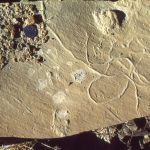 Random Eocene feeding traces, delta plain, Iceberg Bay Fm. Axel Heiberg Island. ?Planolites
Random Eocene feeding traces, delta plain, Iceberg Bay Fm. Axel Heiberg Island. ?Planolites
 Multiple crossing trails in Cambrian shelf deposits on rippled sandstone, Cathedral Mountain, Alberta.
Multiple crossing trails in Cambrian shelf deposits on rippled sandstone, Cathedral Mountain, Alberta.
Ophiomorpha, with typical ornamented burrow lining. Both images from the Paleocene Wangaloa Fm, Otago coast, NZ.
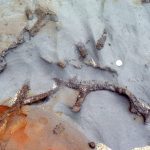 Paleocene Ophiomorpha, Wangaloa Fm, Otago coast.
Paleocene Ophiomorpha, Wangaloa Fm, Otago coast.
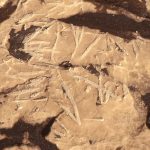 Ophiomorpha filled with volcanic ash, Ngarupuru Fm, North Taranaki
Ophiomorpha filled with volcanic ash, Ngarupuru Fm, North Taranaki
Ray jetting holes (feeding), in basal Waitemata Basin shallow shelf deposits (Lower Miocene). The holes are filled with poorly sorted grit and shell fragments. Some holes overlap. The right image shows the density of holes over several square metres. Matheson’s Bay, Auckland.
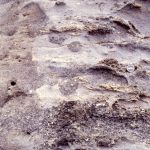 Another view of ray jetting holes (feeding), in Lower Miocene basal Waitemata Basin shallow shelf deposits, The Outpost, Auckland.
Another view of ray jetting holes (feeding), in Lower Miocene basal Waitemata Basin shallow shelf deposits, The Outpost, Auckland.
Left: recent Pholad borings into indurated greywacke. Fragments of the bivalve shells remain. Diameter of the coin (top left) is about 25mm. Right: Lower Miocene Pholad borings into a greywacke sea-stack (eventually blanketed by turbidites) in basal Waitemata Basin shelf-beach deposits. The borings are mostly filled with mudstone. Matheson’s Bay, Auckland.
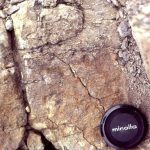 Intense bioturbation has all but obliterated primary depositional layering, Paleocene, Expedition Fm. Ellesmere Island.
Intense bioturbation has all but obliterated primary depositional layering, Paleocene, Expedition Fm. Ellesmere Island.
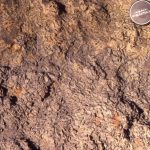 Abundant Chondrites have completely churned this shelf deposit. Grizzly Gorge, Yukon.
Abundant Chondrites have completely churned this shelf deposit. Grizzly Gorge, Yukon.
 Exhumed, calcite-cemented burrows in Permian calcarenite, Canon Fiord Fm, Vesle Fiord, Ellesmere Island. These critters enjoyed fairly high energy wave-current activity, indicated by grain-size and cross bedding.
Exhumed, calcite-cemented burrows in Permian calcarenite, Canon Fiord Fm, Vesle Fiord, Ellesmere Island. These critters enjoyed fairly high energy wave-current activity, indicated by grain-size and cross bedding.
 Small sand mounds produced during bivalve (Paphies subtriangulata) feeding and expulsion.
Small sand mounds produced during bivalve (Paphies subtriangulata) feeding and expulsion.
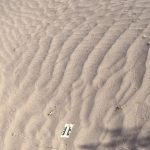 Abundant invertebrate, and one hopping vertebrate tracks and trails on Death Valley dune sands.
Abundant invertebrate, and one hopping vertebrate tracks and trails on Death Valley dune sands.
 Numerous sand-filled, unlined burrows in Late Pleistocene, vegetated sand-dune flat. Great Exhibition Bay, NZ.
Numerous sand-filled, unlined burrows in Late Pleistocene, vegetated sand-dune flat. Great Exhibition Bay, NZ.
Pseudo-burrows, formed as reduction spots in Late Pleistocene dune sands. Reduction commonly occurrs around small plant fragments. The host sands are a brownish colour from iron mineral oxidation. Note the primary dune laminae that pass through the spots. Late. Great Exhibition Bay, NZ.
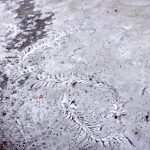 A very pretty trace fossil, but at the time I saw it, of unknown affinity, in Point Lobos submarine canyon strata. If anyone knows more about this, let me know.
A very pretty trace fossil, but at the time I saw it, of unknown affinity, in Point Lobos submarine canyon strata. If anyone knows more about this, let me know.

